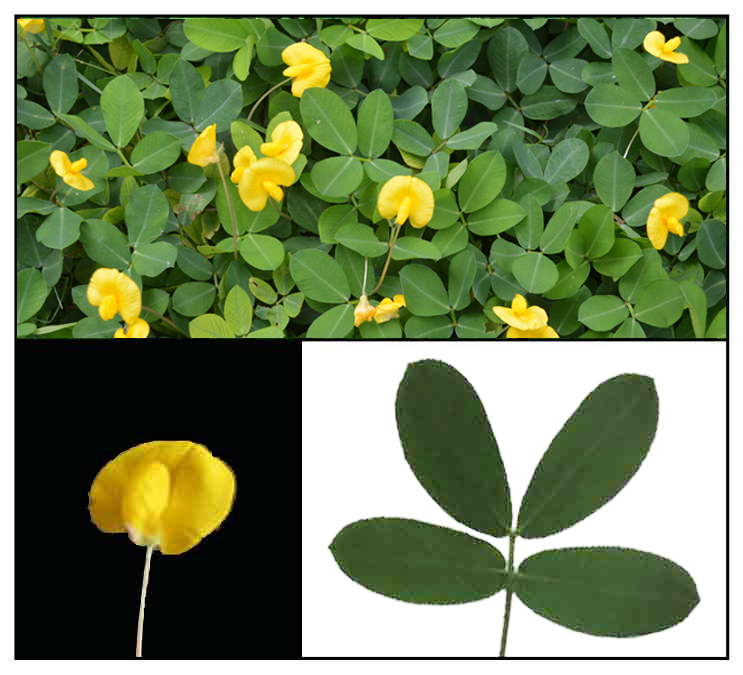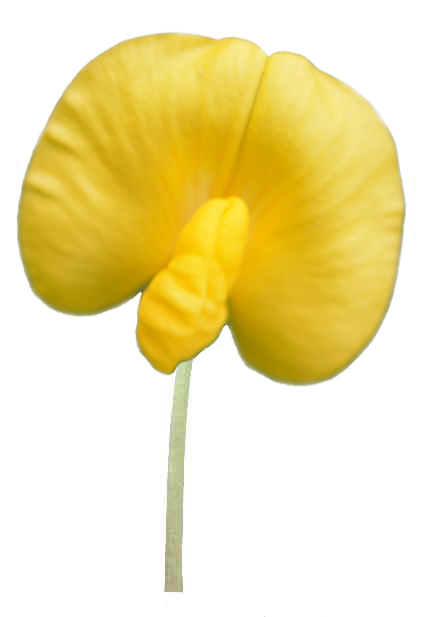 Gen info Gen info
- Etymology: The genus name 'Arachis' derives from 'arakis', the Greek term for legume. The specific epithet 'pintoi' honors the Portuguese explorer and colonial administrator of Africa, Alexander Alberto da Rocha de Serpa Pinto (1846-1900). (25) An alternative attribution ascribes the specific name pinto to the Brazilian botanist Geraldo Pinto, who first collected the plant from the locality of Boca do Corrego, municipio de Belmonte in 1954. The species was first described by A. Krapovickas and W. Gregory in 1994. (14)
- Yield: Pinto peanut can produce 5 t DM/ha/year in pure stands under shade and 3 t/ha/year in full light. (19)
- While Arachis pintoi is called 'peanut plant' because of it is related to the peanut plant, Arachis hypogea. However, A. pintoi is a forage plant and does not produce peanuts.
Botany
• Mani-manian is a prostrate, stoloniferous, perennial tropical legume, growing about 8 inches high. Stems grow along the ground and root at the nodes. Leaflets are oval, four on each petiole. Flowers are yellow, borne on short axillary racemes. Flower stalks elongate and grow down into the soil. Fruit is a terminal one-seeded underground pod, light brown, 1 to 1.5 centimeters long, 6 to 8 millimeters in diameter.
• Pinto peanut is a stoloniferous perennial creeping legume that can reach 20-50 cm in height and form dense swards. It is strongly tap-rooted and has many secondary nodulated roots. The stems are initially prostrate and then become ascendant. The leaves are tetrafoliolate. The leaflets are oblong-obovate to obovate in shape, 4.5 cm long x 3.5 cm broad, glabrous and darker green at their upper side and pubescent underneath. The flowers are yellow, borne on short axillary racemes and very similar to groundnut flowers but smaller. Like groundnut, once pollinated, the flower stalks elongate and grow down into the soil, penetrating up to a depth of about 7 cm. The fruit is a terminal underground, one-seeded pod, 1-1.5 cm long and 6-8 mm in diameter. It is found in the upper 10 cm of the soil. (14)
• Growth form: Low herbaceous leguminous shrub. Spreads by rhizomes and creeping stolons that root at nodes to form a dense ground-hugging mat. Foliage: Leaves pinnately-compound, each with 4 small oval leaflets that are pubescent on the lower surface. Leaves are shed during extended dry periods. Flowers: Bright yellow, pea-shaped, produced on short axillary racemes. Free-blooming. Fruit: Seedpods reticulated, with small brown seeds. Pod production not observed under local conditions. Roots: Distinct taproot. Dense network of fibrous roots, up to 20cm long, with nodules that harbor nitrogen-fixing bacteria. (25)
Distribution
- Introduced.
-
Native to Brazil.
- Spread to Argentina, Australia, and the U.S., later on to the Pacific, Southeast Asia and Central America. (7)
- Planted as ornamental landscaping ground cover.
- Used as alternative cover crop for perennial crops: mango, avocado, coffee, banana, palm oil, pineapple, etc.
- Cultivated
for forage.
Constituents
- Leaf consists of 60-70% dry matter digestibility, 13-25% crude protein, and low levels of condensed tannins.
- As forage, yields high nutritional value with 13-25% crude protein content, 60-70% dry matter digestibility and low levels of condensed tannins.
Properties
- Seedlings develop quickly, reaching ground cover spread by 6 months through its system of stolons.
- Persistence is attributed to the rooted stolons.
- Little biomass, lacks deep penetrating roots, and takes 4-6 months to establish a ground cover.
- Tolerant of heavy grazing because of persistent stolons.
- A forage plant with slower growth rate serving as cover crop capable of replenishing soil nutrients and physical properties. (17)
- Studies have suggested antioxidant, anthelmintic, phytoremediative, cytotoxic, herbicidal properties.
Parts used
Leaves.
 Uses Uses
Edibility
- Flowers are edible; a color ingredient to soups and salads.
Folkloric
- In the Bikol area, leaves crushed and rubbed over insect and centipede bites.
Others
- Fodder: Studies suggest potential as forage plant. Used as permanent pasture for intensive grazing systems. (•)
Its stoloniferous growth habit, subterranean seed production, high forage quality, and acceptability to grazing cattle are of particular value. (8) In Caqueta, Columbia, used by livestock farmers to improve milk yield in cows. In Brazil, valued by farmers as a herbaceous pasture and cover legume. (6) In the Philippines, used for free range kabir chickens, horses, pigs, tilapia, cat-fish, goats and cows.
- Agroforestry: Potential for erosion control
along the exposed benches of city and country roads.(•) Used as live mulch for soil conservation and weed suppression, especially in shaded situations such as under trees and vines. (19) Contributes to the mitigation of environmental impacts (reduction of greenhouse gas emissions) and soil improvement (nitrogen fixation, reduction of fertilizer use), as well as to pests and disease management. (22) Potential as biomulch in tropical upland agriculture. (see study below) (23)
- Cover crop: A good cover crop that can completely cover the soil in less than 6 months (Ecocrop, 2014). It was assessed as a cover crop in banana plantations in the West Indies and in Costa Rica,
where it was suggested it could decrease nematode infestation (Queneherve et al, 2002; Vargas-Calvo, 1998). (19)
Studies
• Feeding System Intensifying Dairy Production:
In Costa Rica's Pacific coastal region, the pasture association Brachiaria decumbens and Arachis pintoi increased daily milk production of Jersey cows.
Although the Jersey cows used in the trial received as supplement a feed concentrate of 14% CP and 2.4 Mcal ME, the beneficial effect of Arachis on milk production could still be observed.
The persistence of A. pintoi during the four years of the evaluation contributed to maintaining production and pasture quality, (4)
• Contribution to Animal Productivity: The perennial peanut (Arachis pintoi) in association with stoloniferous grasses has resulted in productivity increases of 15% milk and 20% beef in experimental plots, with the additional benefit of increasing soil biological activity, notably in the form of higher earthworm populations. It also reduces soil erosion problems and allows the release of on-farm land not suited for grazing for other uses such as reforestation.
(5)
• Anthelmintic / Haemonchus contortus Infective Larvae / Role of Tannins: Study investigated the in vitro anthelmintic activity of five tropical legume plants against Haemonchus contortus infective larvae. At highest concentration, A. pintoi completely inhibited the exsheathment process of H. contortus. The
anthelmintic effect was blocked by the removal of tannin by the addition of polyethylene glycol. (9)
• Phytoremediation / Arsenic Contamination in Coal Ash Dumping Site: Coal ash is a hazardous waste product from coal thermal power plant for electricity generation. CA contains heavy metals which pose an impact on human health and environment. Study investigated the remediation ability of A. pinto. Accumulation of Arsenic was found in root tissue higher than upper parts and remediated up to 11.992%. Results showed the plant had capability to grow and potential to remove As from coal dumping site. (10)
• Antioxidant / Leaves: Study evaluated oven dried and freeze dried ethanol extracts of four common forage legume leaves, viz., Arachis pintoi (Pintoi), C. mucunoides (Calapo), Centrosema pubescens (Centro) and Stylosanthes guanensis (Stylo) for antioxidant activity. All four type of forage legume leaves exhibited strong scavenging effects to DPPH radicals, strong reducing power, and high ß-carotene bleaching inhibitory activities with respect to phenolic content. Arachis pintoi total phenolic content was 7.5 mg GAE/g.
Freeze-dried extracts exhibited excellent antioxidant capacities with higher phenolic content. (12)
• Soil Cover for Vegetable Production: In the Philippines, strip-split design of experimental plots were established in 2007, aimed to look at its effect as cover crop and drip irrigation for the production of commercial vegetables such as Chinese cabbage, cabbage, tomato, bell pepper and carrots. (15)
• Ingredient of Chinese Medicine for Treatment of Mammary Gland Hyperplasia: Invention study reports on the composition of a traditional Chinese medicine for the treatment of hyperplasia of the mammary glands and its preparation method. The raw materials, by weight, are:10-30 parts arachis pintoi, 10-30 parts pratia fruit, 15.-25 parts stenoloma chusana, 10-30 parts prunella vulgaris, 2-8 parts rhizoma cyperi, and 2-8 parts of tangerine seed powder. Pure rice wine is used as guiding drug and water added for decoction. (16)
• Review / Strengths and Limitations: Literature review enumerates strengths and limitations of A. pintoi. Limitations are expensive establishment, poor growth in drought conditions, slow establishment, poor germination, insect and pest competition and weed competition. Once established, limitations are reduced. Benefits are listed as: excellence for soil conservation, improvement of soil quality, good source of compost, promotion of tree growth, livestock feed, suppression of weed growth, and a hardy environmental plant. (18)
• Cytotoxicity Against Leukemic and Tumor Cell Lines / Oil: The seed oil contains high levels of phytosterols, mainly ß-sitosterol, which has been associated with
biological properties, including cytotoxicity against different types of cancer. Study evaluated the cytotoxicity of seed oil against five cancer cells lines by MTT assay. The F41 fraction of the oil exhibited higher cytotoxic potential than the crude seed extract, reducing K562 leukemia cell viability by 73% (IC50 85 µg/mL). The fraction yielded four fatty acids: 13-cis-octadecanoic, linoleic, hexanoic, and palmitic acids, with previously described antiproliferative activity against cancer cell lines. (20)
• Natural Herbicide for Paddy Rice: Study evaluated the allelopathic effects of A. pintoi and its potential allelochemicals using GC-MS. In laboratory bioassays, aqueous extracts of powder exhibited average inhibition of Echinochloa crus-galli (55.1%), Oryza sativa (77.1%), and Vigna radiata (60.1%). Among three solvent extracts, a hexane extract showed highest suppression of E. crus-galli and L. sativa. From the extracts, GC-MS analysis identified 35 substances, including 14 newly constituents such as phenolic acids, stearic acid, palmitic acid, fatty acids, pyranones, and benzofurans, which may be responsible for the herbicidal effects. Results suggest a potential source of bioherbicide as alternative to harmful synthetic herbicides and enhance rice yield. (21)
• Potency as Biomulch in Tropical Upland Agriculture: The total upland area of the slopes of Java Island and Sumatra Island i 10.8 million and 33.7 million hectares respectively. The potential danger of erosion and land degradation is high with its average rainfall of more than 2000 mm year. Study evaluated the effectiveness of A. pintoi in suppressing the rate of soil erosion, weed growth emphasis, improvement of physical and chemical properties of the soil and its application as bio mulch on minimum tillage system. Results showed A. pintoi has slow growth at the beginning, but covers the soil surface perfectly after 19 weeks, effectively suppressing erosion, reducing evaporation from soil, maintaining availability of groundwater, soil organic matters, while providing increased availability of N and P nutrients, as well as suppressing growth of weeds. The combination of minimum tillage and A. pintoi biomulch as potential as alternative method of cultivation in tropical upland. (23)
• Phytoremediation Potential for Lead Contaminated Water: Study evaluated the phytoremediative properties of A. pintoi, such as ability to absorb heavy metals like lead and clean polluted wastewater. Results showed Arachis pintoi as phytoremediative potential to clean-up lead contaminated water in a cost-effective and environment-friendly way. (26)
Availability
- Wildcrafted.
- Cultivated.
- Seeds and seedlings in the cybermarket.
|

 Gen info
Gen info Uses
Uses


